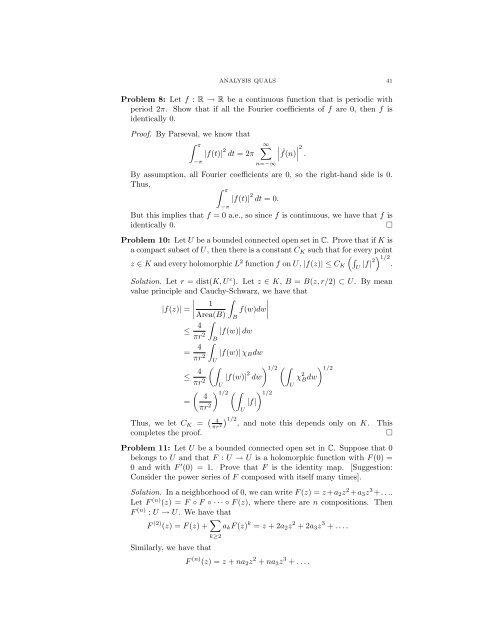ANALYSIS QUALIFYING EXAM PROBLEMS BRIAN LEARY ...
ANALYSIS QUALIFYING EXAM PROBLEMS BRIAN LEARY ...
ANALYSIS QUALIFYING EXAM PROBLEMS BRIAN LEARY ...
You also want an ePaper? Increase the reach of your titles
YUMPU automatically turns print PDFs into web optimized ePapers that Google loves.
<strong>ANALYSIS</strong> QUALS 41<br />
Problem 8: Let f : R → R be a continuous function that is periodic with<br />
period 2π. Show that if all the Fourier coefficients of f are 0, then f is<br />
identically 0.<br />
Proof. By Parseval, we know that<br />
π<br />
−π<br />
|f(t)| 2 dt = 2π<br />
∞<br />
n=−∞<br />
<br />
<br />
ˆ <br />
<br />
f(n)<br />
By assumption, all Fourier coefficients are 0, so the right-hand side is 0.<br />
Thus,<br />
π<br />
−π<br />
|f(t)| 2 dt = 0.<br />
But this implies that f = 0 a.e., so since f is continuous, we have that f is<br />
identically 0. <br />
Problem 10: Let U be a bounded connected open set in C. Prove that if K is<br />
a compact subset of U, then there is a constant CK such that for every point<br />
z ∈ K and every holomorphic L2 function f on U, |f(z)| ≤ CK<br />
.<br />
2<br />
.<br />
U |f|2 1/2<br />
Solution. Let r = dist(K, U c ). Let z ∈ K, B = B(z, r/2) ⊂ U. By mean<br />
value principle and Cauchy-Schwarz, we have that<br />
<br />
<br />
|f(z)| = <br />
1<br />
<br />
<br />
f(w)dw<br />
Area(B)<br />
<br />
B<br />
≤ 4<br />
πr2 <br />
|f(w)| dw<br />
B<br />
= 4<br />
πr2 <br />
|f(w)| χBdw<br />
U<br />
≤ 4<br />
πr2 <br />
|f(w)|<br />
U<br />
2 1/2 <br />
dw χ<br />
U<br />
2 1/2 Bdw<br />
<br />
4<br />
=<br />
πr2 1/2 1/2 |f|<br />
U<br />
Thus, we let CK = 4<br />
πr2 1/2, and note this depends only on K. This<br />
completes the proof. <br />
Problem 11: Let U be a bounded connected open set in C. Suppose that 0<br />
belongs to U and that F : U → U is a holomorphic function with F (0) =<br />
0 and with F ′ (0) = 1. Prove that F is the identity map. [Suggestion:<br />
Consider the power series of F composed with itself many times].<br />
Solution. In a neighborhood of 0, we can write F (z) = z +a2z 2 +a3z 3 +. . ..<br />
Let F (n) (z) = F ◦ F ◦ · · · ◦ F (z), where there are n compositions. Then<br />
F (n) : U → U. We have that<br />
F (2) (z) = F (z) + <br />
akF (z) k = z + 2a2z 2 + 2a3z 3 + . . . .<br />
Similarly, we have that<br />
k≥2<br />
F (n) (z) = z + na2z 2 + na3z 3 + . . . .
















